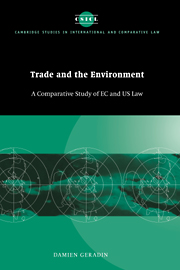Book contents
- Frontmatter
- Contents
- Preface
- Table of cases
- Table of legislation
- List of abbreviations
- Introduction
- PART 1 NEGATIVE HARMONIZATION
- 1 The case law of the Court of Justice
- 2 The case law of the Supreme Court
- 3 Comparative analysis
- 4 Judicial and legislative intervention
- PART 2 POSITIVE HARMONIZATION
- Conclusion
- Bibliography
- Index
- CAMBRIDGE STUDIES IN INTERNATIONAL AND COMPARATIVE LAW
1 - The case law of the Court of Justice
Published online by Cambridge University Press: 29 September 2009
- Frontmatter
- Contents
- Preface
- Table of cases
- Table of legislation
- List of abbreviations
- Introduction
- PART 1 NEGATIVE HARMONIZATION
- 1 The case law of the Court of Justice
- 2 The case law of the Supreme Court
- 3 Comparative analysis
- 4 Judicial and legislative intervention
- PART 2 POSITIVE HARMONIZATION
- Conclusion
- Bibliography
- Index
- CAMBRIDGE STUDIES IN INTERNATIONAL AND COMPARATIVE LAW
Summary
The principle of free trade
Article 3 of the EC Treaty states that, in order to achieve the general objectives of the Community expressed in Article 2 of the Treaty, the activities of the Community include, inter alia:
the elimination, as between Member States, of customs duties and quantitative restrictions on the import and export of goods, and all measures having equivalent effect.
As far as quantitative restrictions on the import and export of goods and measures having equivalent effect are concerned, their elimination is to be achieved through the application to member states' laws of the prohibitions contained in Articles 30 and 34 of the Treaty respectively.
Article 30 of the Treaty provides that all quantitative restrictions on imports and measures having equivalent effect shall be prohibited between member states. The concept of quantitative restrictions is relatively straightforward. Quantitative restrictions were defined by the Court of Justice as ‘measures which amount to a total or partial restraint of, according to the circumstances, imports, exports or goods in transit’. The definition of the concept of ‘measure having equivalent effect’ has created more difficulty. After an initial attempt at definition by the Commission, this concept has been interpreted by the Court of Justice in its leading judgment in Procureur du Roi v. Dassonville et al. as covering:
all trading rules enacted by Member States which are capable of hindering, actually or potentially, directly or indirectly, intra-Community trade.
- Type
- Chapter
- Information
- Trade and the EnvironmentA Comparative Study of EC and US Law, pp. 9 - 33Publisher: Cambridge University PressPrint publication year: 1997



